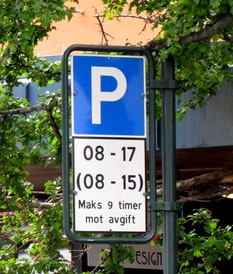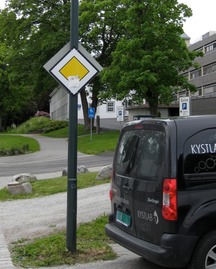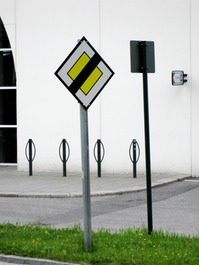Before Norway slips out of our memory bank entirely--don’t laugh, it’s getting easier and easier for that sort of thing to happen--here’s a tutorial of miscellaneous notations for Americans driving around parts of Europe.
Followed, with your indulgence, by a rant.
1. The first bit of notation is specific to Norway and Sweden (and maybe Finland and Denmark, too, but we haven’t been there yet):

Numbers like these appear on parking signs and shop fronts; occasionally they’re even painted on buildings. They refer to things like a store’s opening hours or, as here, the times of day when you need to feed the parking meter. The first set of numbers refers to Monday through Friday hours; the second, in parentheses, is for Saturday; occasionally you’ll also see a second set of parentheticals for Sunday. (You won’t often see that second set in Norway because just about everything in the country is closed on Sunday.)
2. If you do find a grocery open on Sunday in Norway and make your way to the beer cooler, you may see this:

If the store is not in a high-density-tourist area, the helpful explanatory sign will be missing, leaving only the piece of canvas covering the beer cooler, as if to avoid taunting you with the sight of what you’re not allowed to buy on Sunday.
3. These next two are important, and they can be found all over Europe. They can cause more trouble than you might think, especially for American drivers, who aren’t used to them.


You’ll usually see the first sign (top left) along major highways. It means you are on a “priority” road, i.e., you don’t have to yield to traffic that is intersecting your road; instead, if the intersection is not controlled by a traffic light or a sign of some sort, you can drive through the intersection as if the other vehicles did have a stop sign.
And, after you’ve been driving in Europe and seen lots of black diagonal slashes on signs, you know that the sign on the bottom right one means you are on a “non-priority” road. Usually, you’ll see it on a highway that formerly had had priority status but has had that status suspended in a built-up area.
So what’s the big deal about non-priority roads? It’s this: when you’re on a non-priority road you are required to yield the right-of-way to any traffic entering your road from your righthand side.
The point of this practice, I’m told, is to reduce the speed of all traffic in a built-up area by making all drivers, regardless of the nature of the road they’re on, come to a stop when a vehicle approaches from their right (again, intersections controlled by traffic lights or some other signage are an exception).
One problem with this practice is that the poor driver--usually American--busily trying to cope with city traffic, pedestrians at crosswalks, signage in a foreign language, traffic signals in unfamiliar locations at intersections, etc., now has yet another thing to notice and keep track of: “Now I’m non-priority . . . OK, now I’m priority again . . . [crash] . . . oops, I guess I missed that last non-priority notice. . . .”
Another problem is that the whole system depends on every driver at an intersection knowing the “priority” status of every other driver’s roadway. If I’m on a non-priority road when I approach an intersection, my success at avoiding a collision may depend on whether I know the “priority” status of the guy approaching the intersection from my left: if (I know) the other road has priority, I yield; if (I know) it does not, I don’t; but (here’s the kicker) if I think I know but I’m wrong, there’s a 50-50 chance I’ll be pulling into the intersection in front of a driver who wasn’t planning to stop.
Happy motoring.
4. The Rant
Norway is justifiably proud of Henrik Ibsen. After all, the history books call him “The Father of Modern Theatre” (that should be “European” or “Western” Modern Theatre, but who’s counting).
And so:
--while he was living abroad for decades, building his international reputation by churning out masterpieces that trashed his native land for its philistinism and provincialism (and weather), his fellow countrymen bore it in silence;
--when toward the end of his life he deigned to return to Norway to live, they showered him with honors;
--when every noon he entered the Grand Cafe in Oslo for his customary midday meal, they rose from their tables and remained standing until he was seated (or so the waiter there assured us when we asked which was his table);
--at his death, they established three museums to him in places he’d lived around the country. (And, maybe most remarkably, they saw to it that the commentaries on his life and works in these museums were exceptionally insightful and the tour guides staffing them extraordinarily knowledgeable about his life and personality.)
--And, of course, they also erected his statue in front of the National Theatre in Oslo

and bade the artists working there keep his plays alive so that (as they love to point out . . . but modestly, ever so diffidently) he will continue to be the second-most-performed playwright--trailing only Shakespeare. And that, unlike the “Father of Modern Theatre” business, is not only in Europe or the West but throughout the world.
So then: Truly, Ibsen was a remarkable talent, and Norwegians are rightfully proud of his legacy and should do what they can to keep it alive around the land. Most particularly, they should do so at the country’s flagship dramatic institution, the National Theatre in Oslo (where they erected his statue, remember).
Ahem.
About that National Theatre.
But first, about Oslo:
Oslo is, of couse, the capital city of Norway, and many roads lead to it.
And Norway is one of the many countries in Europe that (virtually) shuts down during the month of July and sends (nearly) everybody off on vacation.
And because Oslo is the capital city and many roads lead to it,
--and because Norwegians are a really patriotic people,
--and also because Oslo is pretty far south (pretty far for Norway, anyhow), so the weather there might be expected to be warmer than most other places in the country . . .
for all these reasons, lots and lots of Norwegians spend at least part of their vacation … in Oslo.
(And lots of other Europeans come there, too, as well as quite a few Americans, because it’s a really lovely city, and because maybe they can learn somthing--you think?--from the people of Norway about things like . . .
oh, I don’t know . .
things like how to keep their citizens alive longer at less cost
and how to give science a leading role in establishing policies about their environment
and how to discourage drunk driving by taking away their licenses at the slightest whiff of alcohol instead of this “.06,” “ .08” crap,
and how to encourage healthy family life with maternity and paternity leaves at full pay and subsidized early childhood education and don’t get me started. . . .
(But I digress.
Where was I?
Oh, yes.)
So the point is--the points are--
(a) Ibsen continues to be really important to Norwegians and to the country’s cultural identity;
(b) there are hoardes of Norwegians in Oslo in July;
(c) Oslo is where the National Theatre, dedicated to the preservation of Ibsen’s works, is; and
(d) seeing a first-class production of one of a guy’s plays--instead of just reading it, say, or, God help us, being reduced to talking about it in a classroom--seeing a play is a really good way of coming to appreciate the work and how the guy’s mind works.
(Can you see where I’m going here?)
Conclusion: July would be an awfully good time for Norway’s National Theatre to be busy as hell, doing Ibsen plays as well as they can do them. . . .
But they don’t do it!
The National Theatre is closed.
And not just in July: it’s closed all summer!!
WHAT’S UP WITH THAT?
